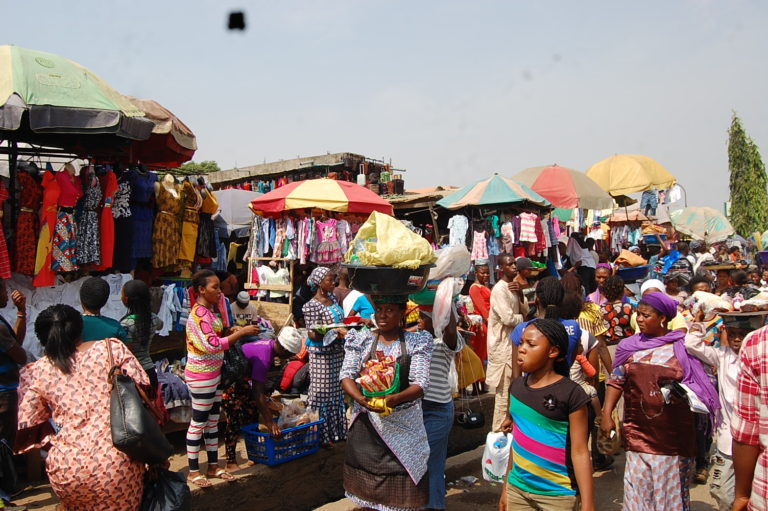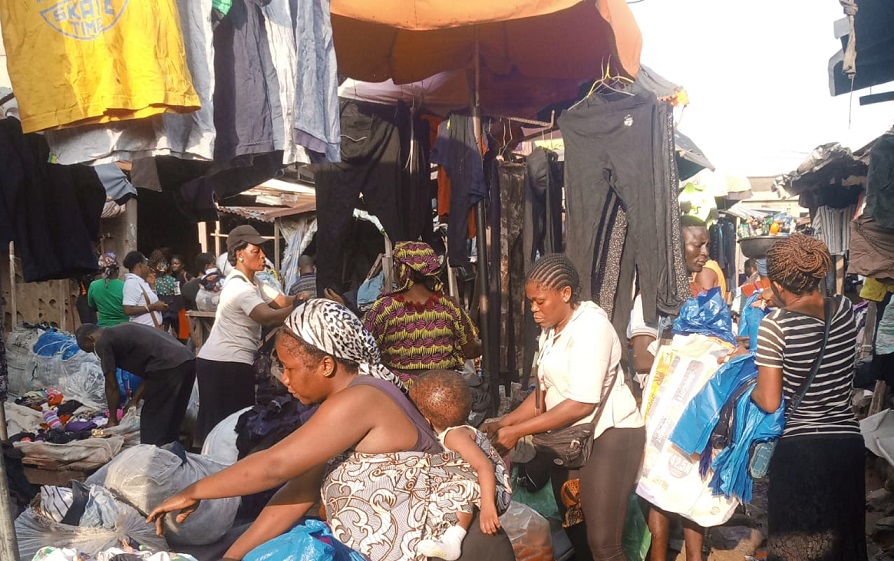Dear Beamers,
Greetings! In a nation such as Nigeria, the practice of thrifting and donning thrifted clothing is widely recognized. Broadly, it can be regarded as an avenue for personal fulfillment. Engaging in thrifting, encompassing the procurement and utilization of second-hand garments, is not merely a marginal pursuit. It is crucial that we embrace thrifting, given the unsustainable pace of clothing consumption. This week’s newsletter endeavors to explore the significance and societal perception of thrifting within the Nigerian society.
“Okrika” serves as the overarching term for second-hand clothing in Nigeria, with its etymology tracing back to the eponymous port town of Okrika, located in proximity to Port Harcourt. Historically, Okrika functioned as the primary entry point for second-hand garments into Nigeria, thus establishing its association with the trade. Consequently, the term “Okrika” has persisted as the colloquial designation for all second-hand clothing within the country.
The practice of purchasing Okrika attire traces back to an era before Nigeria’s establishment of clothing manufacturing infrastructure. During this period, the prohibitive expenses associated with importing new garments, compounded by the logistical challenges of the importation process, rendered new clothing financially inaccessible to many. Consequently, a burgeoning market for second-hand attire emerged, enabling many Nigerians to sustain their households through the trade of Okrika garments.
Some individuals believe that second-hand clothing originates not from prior usage but rather as a byproduct of discarded industrial production. Garments are manufactured in anticipation of an artificially inflated demand, leading to an excess of unsold inventory which subsequently enters the second-hand market. Due to both this surplus and the societal stigma associated with used clothing, a significant portion of these discarded garments ultimately finds its way into landfills, rendering them effectively useless.
In Nigeria, second-hand garments, commonly referred to as Okrika, also go by various other names such as “fairly-used” or “tokunbo.” Additionally, one colloquial term used is “bo si corner,” which blends English and Yoruba languages, translating to “go to a corner.” This expression reflects the societal perception of purchasing used clothing as a source of shame, leading buyers to seek anonymity by conducting transactions away from public view. Given that Okrika offers affordable alternatives to new and authentic attire, it is typically favored by individuals facing financial constraints. Consequently, buyers often opt to shop discreetly, either during the early hours of the day or in secluded corners where Okrika vendors typically operate their stalls.
“Okrika today isn’t hidden; it’s a thriving business gaining popularity. It’s not just the older folks; even the youth are into it. With high unemployment, many, both old and young, have no choice but to start their own businesses. Nigeria’s tough economy has pushed many into the trade, making Okrika a viable and growing profession. Still, it’s really competitive, and not all can keep up with the competition in the Okrika market.” Says Chigozie Hope
The Okrika business presents a significant opportunity for many young Nigerians today, offering the potential for substantial earnings through the sale of second-hand clothing. Consequently, it serves as an attractive avenue for entrepreneurial endeavors. However, prospective entrepreneurs should acknowledge that the Okrika trade has operated for several decades, necessitating the development of a unique marketing plan and strategic approach, similar to any other business venture.

The dynamics of globalization and industrialization have transformed the fashion sector from a craft practiced by a select few into an industry propelled by mechanization. This proliferation of manufacturing processes has led to a surplus of clothing that often fails to meet genuine market demand. Consequently, establishing a business focused on the sale of Okrika attire has become a viable option within our society. Success in this endeavor hinges on a comprehensive understanding of the Okrika procurement process, whether sourced locally or internationally.
According to Idowu Rhoda, a seller of thrift wear,
“Okrika clothes are sourced from various global regions, especially Europe, Asia, the United Kingdom, and the United States of America. Europe and the USA are renowned for yielding the highest-quality garments. However, the quality ultimately depends on the individual sellers. These items range from used belts and shoes to t-shirts, with pricing contingent on both the item’s quality and brand.”
She added, “When it comes to purchasing Okrika clothes, buyers have several options based on their transaction needs. For smaller-scale transactions, local textile shops offering wholesale deals are viable options. However, for wholesale endeavors, Lagos is the hub of Okrika trade in Nigeria.”
Okrika stalls, commonly known as second-hand shops or “bend-down select” outlets, earn their monikers from their merchandise’s pre-owned status. The term “bend-down select” stems from the practice of displaying Okrika attire on clean platforms at ground level, facilitating easy browsing and selection for customers who must often stoop to peruse the offerings. Upon selecting desired items, transactions commence.
In some instances, the need to bend down may be obviated as merchants may choose to launder, iron, and showcase select garments on hangers, thereby enhancing their appeal and value. This additional service provision can prove advantageous for customers seeking a more curated shopping experience compared to sifting through piles of clothing.
Okrika sellers are adept at persuading customers to test and try their merchandise, employing various tactics and sales techniques to engage even the most discerning individuals. Utilizing a highly extroverted approach, some sellers assertively promote their thriftwear with the popular saying, “Na Mumu dey go boutique” (only a fool goes to the boutique), emphasizing the notion that comparable quality attire is available at significantly lower prices within their stalls. This reinforces the idea that thriftwear offers equivalent value to boutique offerings but at a more affordable cost.
Sellers demonstrate relentless persistence in encouraging customers to try on garments, often going to great lengths to facilitate this process. Additionally, certain vendors provide mirrors to allow buyers to assess their appearance while extolling the virtues of the attire. These interactions typically precede any discussion of pricing or negotiation. Once the buyer expresses approval of the garment, the bargaining process ensues.
Nigerians opt for second-hand clothing for varied reasons. Some prioritize affordability, while others value the durability that allows garments to be passed down from one child to another. Many individuals prefer to shop for Okrika attire early in the morning to avoid crowds and secure access to premium selections. By arriving early, they ensure availability as soon as vendors unveil a new assortment of clothes and accessories, ensuring the opportunity to choose from the best materials.
There are several compelling reasons that effectively counter the notion of associating the purchase of second-hand clothing solely with financial constraints. One major rationale is the sustainability and environmental friendliness inherent in thriftwear.
The textile industry ranks among the most environmentally detrimental sectors globally. By opting for thrift clothing, consumers diminish the demand for new apparel, thereby mitigating the resource and energy consumption associated with production. Purchasing second-hand garments contributes to mitigating the environmental ramifications of fast fashion, which typically relies on non-renewable resources and carries a substantial carbon footprint. This practice aligns with the principles of sustainable fashion, emphasizing the creation of apparel that minimizes adverse environmental impact.

Furthermore, secondhand clothing boasts various standout attributes that appeal to a diverse range of consumers. Browsing through thrift stores often resembles a treasure hunt, offering the opportunity to uncover rare items not typically found in conventional retail outlets. This affords individuals a unique and personalized sense of style, with the potential to discover vintage, retro, or distinctive pieces that imbue their wardrobe with character and personality.
As indicated by Nwankwo Darlington, a student at a Nigerian university,
“The abundance of Okrika options allows buyers to uncover exclusive items that reflect their individuality. For some, new clothes are deemed inferior, prone to rapid wear and tear, whereas second-hand garments are often regarded as superior, offering durability. The Okrika market stands out as a vibrant space, attracting individuals from all walks of life with its diverse selection. Here, shoppers can explore stacks of clothing, until they achieve a blend of style and affordability that suits their preferences and budget.”
Thrift clothing offers affordability, ensuring that individuals can partake in fashion trends without concern for financial constraints, as there are options available to suit everyone’s budget. Purchasing second-hand clothing from thrift stores often proves significantly more economical than investing in new, upscale attire, thus broadening access to stylish garments across diverse socioeconomic backgrounds. This accessibility fosters greater experimentation with various styles and trends, affording individuals the opportunity to explore different looks without incurring substantial expenses.
Nevertheless, it is important to exercise caution regarding the potential health hazards associated with wearing second-hand clothing, particularly undergarments such as pants and bras. Utilizing undergarments previously worn by another individual poses a risk of transmitting diseases, particularly if the previous wearer had conditions such as skin infections or sexually transmitted diseases. Therefore, buyers must ensure thorough laundering of such garments with antiseptic agents, followed by sun-drying and ironing, to mitigate the risk of disease transmission prior to usage.
In this times, second-hand clothing has emerged as a prominent fashion trend embraced by individuals of varying financial means. It is essential to dispel the notion that low-income earners are the primary consumers of second-hand items, as patronage spans across all socioeconomic classes, contingent upon individual preferences and tastes.
Like epileptic of rise and fall of costs every now and then with an excuse on climate, economy or whatever stated reasons in day to day life, Okrika is a inevitable part of Nigerian life.Ultimately your choice of either wearing a new label, brand or vying for okrika is entirely up to you, it’s not in anybody’s place to determine what is cool for you. Hence it is out of place to tag anyone poor because you prefer purchasing your wears new fresh from the boutique instead of an Okrika store.
Just as costs fluctuate unpredictably due to factors such as climate and economic conditions, Okrika clothing has become an integral aspect of Nigerian society. Ultimately, the decision to opt for new, branded attire or to embrace Okrika garments rests entirely with the individual; no one else can dictate what is considered fashionable for you. Therefore, it is inappropriate to label anyone as financially disadvantaged simply because they choose to purchase their clothing from Okrika stores rather than new from boutiques.




